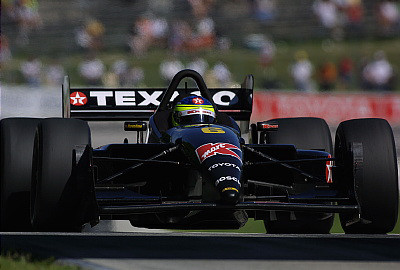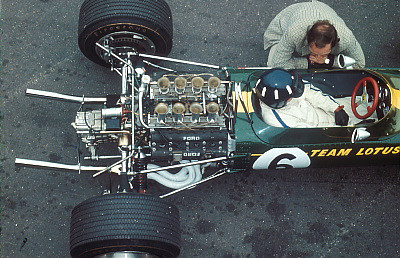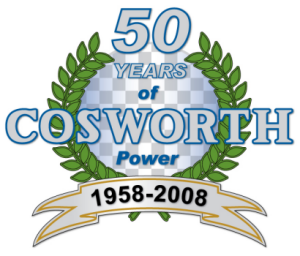The Way It Is/ Both Lola and Cosworth celebrate fiftieth anniversaries in 2008
by Gordon Kirby As we all know, racing is a very demanding business and it's rare to see any racing car constructor or engine builder survive, let along thrive, for very long. Once-great Formula 1 teams from the sixties and seventies like Lotus, BRM, Brabham, Cooper and Tyrrell are long-gone, for example, and production race car manufacturers like March and Reynard are no longer with us.
As we all know, racing is a very demanding business and it's rare to see any racing car constructor or engine builder survive, let along thrive, for very long. Once-great Formula 1 teams from the sixties and seventies like Lotus, BRM, Brabham, Cooper and Tyrrell are long-gone, for example, and production race car manufacturers like March and Reynard are no longer with us.
All American Racers was in business for thirty-four years from 1966-'99, building Eagle F1, Indy and IMSA cars, and probably ranks as the most accomplished American race car constructor. But AAR not longer builds race cars, although the company continues in business building lightweight composite components and devices for the US military as well as doing motorcycle and special engineering projects. In fact, it's difficult to find many race car or engine builders with longer lives than AAR.
Without doubt, Ferrari sets the standard. The great Italian team's roots go back to before WWII, of course, when Enzo Ferrari started fielding Alfa-Romeos in various European races. The first Ferrari Formula 1 car debuted in 1948 and Alberto Ascari scored the marque's first Grand Prix victory in the 1949 Swiss GP, the year before the first modern F1 World Championship was organized. From 1950 through today, Ferrari's official Grand Prix record shows 202 wins, 196 poles and fourteen world championships, plus forty-nine non-championship F1 race wins between 1950-'79 when those events were allowed to take place. It's a pretty stellar record by any measure, particularly when you add Ferrari's nine Le Mans victories and many other world championship sports car wins from the fifties, sixties and seventies.
The only other modern F1 teams with serious histories are McLaren and Williams. McLaren was founded in 1966 and has scored 156 wins and 131 poles. Williams started racing in F1 in 1969 and the team has won 113 races and taken 125 poles. In comparison, the remaining F1 teams--BMW, Renault, Honda, Toyota, Red Bull, et al--are young pups.
The oldest American race teams are Petty Enterprises and the Wood Bros, both in NASCAR. The Petty's roots go back to NASCAR's beginnings in 1949 and the Woods have been in action since 1953. Among the more modern NASCAR teams the oldest is Richard Childress's operation which he started in 1969. Rick Hendrick started his NASCAR team in 1984 and Jack Roush went NASCAR Racing in 1988 after a number of years in IMSA's GTO category. Roger Penske started his race team in 1966 and Carl Haas started fielding a team around the same time although the current Newman/Haas team didn't take shape until 1983. And AAR aside, there are no American race car builders--unless you count Bob Riley's company--which have enjoyed longterm, successful lives.

© LAT USA
Lola is a rare survivor in a business which tends to feature a steady stream of new names, decade by decade, with most of them falling by the wayside after ten or twenty years. The Lola marque has survived and thrived while many other famous English production racing car constructors like March, Ralt and Reynard have gone out of business after relatively short, sometimes fitful lives. Today, Lola is challenged only by Italy's Dallara in the worldwide production racing car business, but the broad sweep of different types of cars manufactured by Lola and its five decades in business puts the company in a category of its own.
A good deal of Lola's history has been written in the United States in CanAm, F5000 and Indy or Champ car racing. Over the years, the company also built and sold a wide range of small-bore racing cars--Formula Fords, Super Vees & Atlantic, Sports 2000 cars, etc--and delivered these cars to a healthy American market in particular through longtime American agent Carl Haas. Chicago-based Haas was Lola's man in America for forty years from 1966-2006 with a short break between 1997-'99 while Newman/Haas developed and raced Swift Champ cars.
Haas's race teams won seven consecutive Formula 5000 and CanAm championships with Lola chassis between 1974-'80. Newman/Haas Racing was formed in 1983 in partnership with legendary actor and amateur racer Paul Newman, and Newman/Haas went on to win eight CART/Champ Car titles over a twenty-five year span with drivers Mario Andretti, Michael Andretti, Nigel Mansell, Cristiano da Matta and Sebastien Bourdais, all but the last of these championships with Lolas.
Known as 'The Professor', founder Broadley was a brilliant designer but perhaps less astute as a businessmen, particularly in the later stages of his career. After Broadley made a famously unsuccessful attempt to return to Formula 1 in 1996, Lola was forced into bankruptcy. During this time the company lost its focus on Champ Car racing and was driven out of the market by new rival Reynard.
Lola was bought in 1997 by Martin Birrane, a successful London-based real estate developer. Irishman Birrane also has enjoyed a long career as an amateur racing driver aboard a wide variety of cars. Birrane is both an enthusiast and a tough-minded businessman, and after he bought Lola he realized the company was in a very bad state of affairs. "Was I going to just run it down?" Birrane remarked. "Or was I going to rebuild it back up to what it was in the past, which was the biggest and best racing car manufacturer in the world? I made the decision to do the second of those choices."
Lola didn't win a single Champ Car race in 1997, '98 or '99 but for the 2000 season Birrane was able to entice Newman/Haas back into the Lola fold and in May of that year Michael Andretti scored the company's first win in forty-five months. Lola won six more races that year with three other drivers and in 2001 Lola once again became the dominant force in Champ Car racing winning ten races as Cristiano da Matta took the championship for Newman/Haas. "Having got there we had what you could say was a pyhrric victory because no sooner had we got to be the dominant chassis and things turned down," Birrane pointed out.
Indeed, both the economy and the overall state of open-wheel racing in America were in decline. "Reynard went bust and a lot of people thought that was good news for us," Birrane said. "But I knew it wasn't because the economy was turning down and people would not be looking to do the same amount of development and improvements so that our huge engineering resource would be underused.
"That was a very painful time for us because we didn't downsize in time and we lost money. Our accounts were blood red. It always takes too long to turn around. It's like turning the Queen Mary. When you know you want to make a change it just takes forever and during that time you're bleeding because you have to pay your overheads and your staff. In the time it took to downsize, it cost us a lot of money."
Lola went from a workforce of 283 people five years ago to 180 people three years ago back up to 240 employees today. "A lot of these additions are in the non-core businesses," Birrane said. "Five years ago we had fifty engineers. That went down to twenty-three three years ago and we've built that back up again to probably thirty. We lost a couple of names but we still had the core team and they remain with us, and we're not afraid to take on any project."
The last Lola Champ car, the B2/00, raced for seven seasons and won seventy-six races. The B2/00 won seven races in its debut season, 2000, and took ten wins in '01, equaling Reynard, the dominant car builder of the time. The B2/00 went on to win sixteen of nineteen races in '02 and seventeen of eighteen races in '03. From 2004-'06, the B2/00 won all the Champ Car races and became the organization's de facto spec car before being retired at the end of '06 and replaced by the cheaper Panoz DP01.
The B2/00 proved to be tremendously reliable, durable, and safe. Lola built eighty-one of these cars, between 2000-'05. For a few of those years the teams were buying fleets of new cars every season, as they had done for years. But then Toyota and Honda pulled out of CART and the organization began to implode. In 2003, CART switched to Champ Car's current Ford/Cosworth spec engine formula, but without the backing of major manufacturers none of the teams had the resources to buy new cars. By the end of '06 when the B2/00 was retired many of the cars had recorded more than 15,000 racing miles.
Today, Lola continues to build a wide range of production racing cars, covering seven classes and seventeen series around the world. These include ALMS LMP1, Grand-Am, A1GP, Formula Nippon, F3 and Sports 2000. Lola also does development work and produces pieces for a selection of F1, sports car, touring car and world rally teams
Birrane says the other parts of Lola Group Holdings are doing extremely well. These include Lola Composites and Altanet Technology, both of which are involved in the development and production of a vast array of aerospace and military projects with BAE Systems and other contractors. Under Birrane's leadership, Lola appears to have positioned itself well for continued future growth beyond motor racing.
"The non-core businesses outside of racing are absolutely flying," Birrane commented. "Lola Group Holdings includes design for outside parties and the composite business has gone into overdrive. We make composite parts for four Formula 1 teams. We also make composites for the ministry of defence for all kinds of military equipment for aircraft and helicopters. That business has really picked up. It went from about $5 million to $10 million turnover to $20 million. That side of the business is going well and the niche engineering is picking up well."

© LAT USA
This exceptional level of performance was established from the outset by founders Duckworth and Costin. Duckworth was a highly-motivated, tart-tongued engineer and engine designer, a true genius and beguiling drinking companion who could hold the entire design of an engine in his head and commit it to paper, piece by piece. One of Duckworth's great prides was to be able to produce a prototype that was as close to complete and functional as possible, a rare feat that Cosworth has been able to come close to achieving time and again.
Costin was an equally brilliant, immensely practical engineer, capable of building pieces and getting things done. He was also an extremely competent racing driver with a record of success in sports car and small formula cars. Costin was Colin Chapman's right-hand man at the fledgling Lotus team from 1956-'62 and once beat Jim Clark to the pole for a Formula Junior race at Goodwood in 1960. Duckworth also worked for Lotus in 1957 and '58 before forming his own little, engine-building company in a former Lotus workshop in partnership with Costin who continued to earn a living by working for Lotus for a few more years
Cosworth started in business by building racing versions of the Ford Anglia 105E four-cylinder engine for the new Formula Junior category introduced in Europe in 1959. The company's first win was scored by no less a man than Jim Clark, the great champion-to-be who drove a Ford/Cosworth-powered Formula Junior Lotus 18 to victory at Goodwood in March of 1960. Over the next four or five years Cosworth engines dominated Formula Junior, Formula 3 and then Formula 2, instantly becoming the most successful engine builder in these categories.
Cosworth's Formula 1 debut came in spectacular style in June of 1967 when Clark won the Dutch Grand Prix driving a brand new Lotus 49 powered by an equally new Cosworth DFV V8. The legendary DFV and its derivatives went on to dominate Formula 1 over the next fifteen years, winning all but two world championships and 155 races through 1983. In 1976 a turbocharged version of the DFV, called the DFX, began winning USAC races in America and over the past thirty years through a series of turbo V8s, including the XB, XD and XF engines, Cosworth became even more successful in Indy or Champ car racing.
In between, Cosworth has built successful engines for many types of motor racing, done development projects for many of the world's major motor manufacturers, including Ford, General Motors, and Mercedes-Benz, and established itself in an unchallenged position as the world's most successful race engine-building and development company.

© Cosworth, LLC
"A smart engineer can do for a penny what a good engineer can do for ten pence," is one of Duckworth's more renowned sayings.
Here are a few more: "Development is only necessary to rectify the ignorance of designers."
"Working things out for yourself from first principles, and providing proper engineering solutions never goes out of fashion."
"Academics are seldom any use at engineering. One must have a mistrust of theorists."
"In engineering there's an answer to everything. It's just that we're usually too ignorant or too dim to see it."
"Very few straight answers are ever possible. The decisive man is a simple-minded man."
And: "It is better to keep your mouth shut and be thought a fool, than to open your mouth and prove it."
Of course, Cosworth's uninterrupted thirty-nine-year run in F1 came to an end last year, resulting in some painful downsizing, just like Lola experienced. In today's manufacturer-dominated F1 world it's doubtful if Cosworth ever will return to F1. Like Lola, Cosworth also is trying to diversify beyond racing and as long as it remains true to its founding principles, the company's proud name will continue to bear fruit in the aerospace and other technologically-advanced industries, not just racing.
Auto Racing ~ Gordon Kirby
Copyright 2007 ~ All Rights Reserved
Copyright 2007 ~ All Rights Reserved
Top of Page